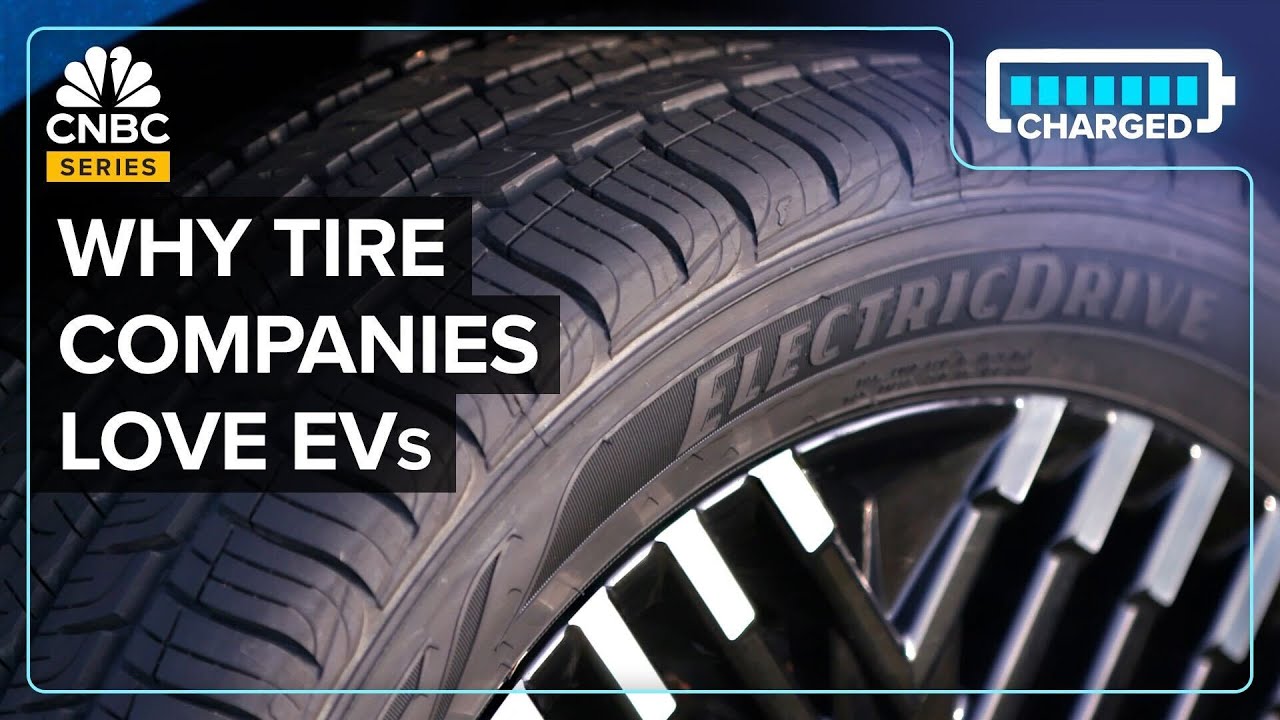The business of tires is a
business of slow change, Slow growth and low
margins. The total market value has
remained around $50 billion In the past few years, and
it isn't expected to grow Much in the coming years
either. I mean, it grows a little
faster than population, but A lot slower than GDP. So, you know, in some ways
it grows slower than Toothpaste, much like the
auto industry generally. The industry is competitive
and highly susceptible to Spikes in raw material
costs, and a lot of buyers Treat its products as
commodities, often not even Knowing the difference
between one brand and Another. Price is usually
the only differentiator, but The future may look a lot
different. Some believe a real move to
EVs will open up a whole new Realm of opportunity. After all, EV tires cost
50% more and need to be Changed 20% more often. The latest tires are
engineered to tolerate an EV's heavier weight and
lightning quick Acceleration. More
importantly, improve the Range. If EV does kind of evolve
and proliferate through the Car population like some
think it may bring about What I call the gold rush
for tire manufacturers. From 2017 to 2022, the US
tire and rubber market grew About 9%, and the top three
tire makers account for more Than half of all tire sales
in the country. Americans bought 330
million tires in 2022, an Increase of less than 1%
from five years prior. Overall demand is expected
to grow about 0.8% through 2027. It's a low growth business,
and it's a product that we
All take for granted to
some degree. So given that backdrop, um,
tires are, uh, what I would Say amongst the most
competitive businesses I Followed over the years. The industry is highly
exposed to raw material Prices, which companies
have little control over. Tires are made up mostly of
rubber, fabric, steel, and Something called carbon
black, which increases Durability and gives them
their tar like color. On the other side of it,
tires are seen by many Buyers as almost like the
very commodities they're Made of. NorthCoast Research's John Healy Estimates that as many as
half of customers are Indifferent to which brand
they choose. Tire changes can't be
forecasted with regularity, Either. Some people drive a
lot, others less. Other factors are the
climate or region you live In and unpredictable events
like punctures. When you take all these
things, whether it's, you Know, the global nature of
the business, the number of Operators and competitors,
there are half of the Customer base that's kind
of buying based on price Rather than brand. And then the inability to
kind of know when those Customers are going to come
to you. It just creates a dynamic
that, you know, on January 1st, it's awfully difficult
to know if your business is Going to grow 3% or if it's
going to decline 3%. One of the main ways that
tire companies compete with Each other is by creating a
differentiated product. And how do you differentiate
your product? You try to make it last
longer. So in essence, the R&D that
tire companies put into Their business is hurting
their DNA over the long run.
It's slowing the frequency
of replacement by having Tires last longer. So it is a it is a really
tough business. Now enter EVs which pose
whole new challenges. We're very good at making
tires for ICE, but EV is a Different a different
animal. At first glance, today's
tire looks a lot like it did 150 years ago. A mostly rubber tube
inflated with air. But a lot of innovation has
taken place since then. Michelin, one of the
largest tire makers in the World, created the radial
tire in 1946. Over the years, the rubber
compounds, the materials That are put in them have
been changed radically. That includes compounds that
stay soft at colder Temperatures, allowing for
hardier winter tires. Today's tires are made of
several types of material Adjustments to these
different ingredients. The types of compounds
used, tread design, and so On can tune the tire for
different types of Performance. Racing tires,
for example, are as slick as Possible. Consider the
entirely treadless rear Wheels on a drag racer,
allowing for a better grip On the road. Tires like
that can slip in wet Conditions. Most road tires
have some kind of tread on Them, in addition to other
tweaks to make them better In bad weather. But treads
slow tires down, hurting Performance, gas mileage or
EV range. Pull on one part of this,
you give up on the other. The real trick is to pull
on several different ways. EVs provide both challenges
and opportunities in ways That help distinguish tire
makers from each other. One interesting one EVs are
a lot quieter than ICE cars, A mixed blessing as it
makes tire noise more
Noticeable. So you think about like the
noise a basketball makes When it bounces. That's the air inside the
tire ringing. As you bounce, the
basketball tire does the Same thing. It's got, you
know, inflated air in it. And as you go over bumps
and do things, it can also Create that. What we see
with some of the platforms Is that there can be a
sensitivity to the way the Vehicle's designed with
that frequency. There are ways to reduce
this, such as inserting foam To dampen the sound. Another challenge:
extending battery range, an EVs most precious resource. Gasoline is still far, far
more energy dense than a Typical EV battery. You get a lot more pound
for pound than a gasoline Car than with the current
lithium ion battery Technology. The battery
pack on the 259 mile range Chevy Bolt weighs about 960
pounds. The comparable gas powered
Chevy Cruze can travel Nearly 550 miles on a
single fill-up. Its fuel tank holds 13.7
gallons, which weighs just Above 80 pounds. Researchers are, of course,
racing to change this. While EV batteries don't
store energy as efficiently As gasoline does, EVs do
deliver that stored energy Far more efficiently. Only about 16 to 25% of the
energy stored in a gallon of Gas will actually power the
wheels, among other things, A fuel burning engine loses
about 65 to 72% of its Energy to heat, radiating
off the engine and other Parts of the car. EVs, however, deliver about
two thirds of their energy
To the wheels more if there
are energy recovery Technologies like
regenerative braking. Vehicles also lose energy
through tires through Something called rolling
resistance. Basically, just a force
that slows a tire down as it Rolls. The same force that
would slow down and stop a Rolling ball. Because EVs don't suffer
energy loss through engines, Reducing that energy loss
through tires has become Much more important to
making EVs as efficient as Possible. Improving the
tire can have a dramatic Impact on an EVs range. We've done studies that have
shown that you can impact The range of an electric
vehicle by as much as ten, Maybe even 15%, depending
on your tire choice. That means if a vehicle has
300 miles of range, you can Get an additional 45 just
from using the right tires. One key challenge, and the
one that could be the Biggest boon for tire
makers: EVs burn through Tires. This might be the first
thing from an auto market Development standpoint in
decades that actually causes Tire demand to increase. EVs weigh a lot more than
comparable ICE vehicles. The Kia Niro EV, for
example, is about 20% Heavier than its Ice
counterpart. This isn't perfect, but a
GMC Sierra 1500 pickup with A turbo diesel engine has a
curb weight of about 5,540 Pounds. The GMC Hummer EV
is almost twice that. EVs also accelerate faster
than Niro, with an engine Accelerates from 0 to
100km/h in about 10.4 Seconds max. The Niro EV does it in 7.8. Many EVs can easily attain
supercar levels of
Quickness. I'm sure you've had the
opportunity to be in an EV, And if you've driven with a
friend in your EV or their EV, one of the first things
they're going to do is They're going to hit the
hit the pedal all the way to The ground, and they're
going to throw you back in Your chair, and you're
going to be pretty Impressed. This is because of torque, a
measure of the power an Engine delivers to wheels. Electric motors don't have
the same constraints as Engines, so they can
deliver torque very quickly, Essentially instantly. That is what throws you
back into your seat. A car taking off like that
will scrub the tires more as They try to grip the road
and accelerate the vehicle, Add more weight on top of
that, and those tires are Scrubbing the asphalt hard. The regenerative braking
feature common on EVs, is an Additional force on the
tire moving in the opposite Direction to slow the
vehicle down. A high performance tire in
general wears out quickly Anyway. Now you put the
load and the extra power on That type of a tire and
it's going to wear out even Quicker. I mean, some of
these vehicles are wearing Tires out in 15, 20,000
miles, which is concerning Because they're wildly
expensive as well. While EVs expand, tt's hard
for me to think it's not a Really good thing for
Goodyear and other Manufacturers. Michelin expects the EV tire
replacement market to grow About 6 to 7% by 2027. It's about 1 or 2% right
now. Analytics firm AlixPartners
says the total market for EV
Tires is expected to grow
at a 33% compound annual Rate through 2031. Meanwhile, ICE vehicle
tires are expected to Decline 2%. The average age of a
vehicle in the US was just Over 12 years in 2023. The firm estimates the cost
of replacing EV tires over That time will be about
twice what it is for Ice Vehicles. EV tires are
about 50% more expensive and Need to be replaced about
20% more often. And we've been hearing this
from tire replacement chains For about 2 to 3 years
consistently. A Tesla vehicle replaces
its tires every 15,000 miles Instead of every 40 or
50,000 miles, and that 15,000 might actually be a
touch on the high side. It might be, you know, even
closer to 12,000 miles. Sometimes, if you think
about that, that creates Kind of an expanding
replacement market annually For tire companies, which
is something that hasn't Happened in decades. The biggest manufacturers
say their EV or EV ready Tires should last a lot
longer than that. Bridgestone Turanza EV tire
has a 50,000 mile limited Warranty, and Goodyear's
ElectricDrive has a 60,000 Mile one. We've developed some of
these new technologies, Regardless of kind of how
quickly that transition Happens. So we're going to
be set up for success in General. But but I think
that we know that the EV Proliferation is going to
happen. It's just a matter Of exactly how quickly it's
going to happen. Then our tires are going to
become more sophisticated And last longer. So as we get five years
out, you know, maybe it's
Not going to be a 12,000
mile replacement. It's going to be an 18,000
mile replacement. So I think you're going to
get a little bit of a Eroding of the replacement
cycle as they improve their R&D into the category. Other tire development
trends pose further Challenges and
opportunities. One is tire Intelligence. The Goodyear
tires that come fitted on The Tesla Cybertruck are
equipped with sensors that Measure tire temperature,
pressure, and how much Rubber is actually in
contact with the road. Pulling that data together
allows for some predictions How much tread is left on
the tire, when will the tire Need to be replaced, and so
on. Another area that has seen
a lot of change is tire Diameter. The ever
increasing size of American Vehicles has boosted demand
for proportional wheels. Rim diameters of less than
18in still make up most tire Replacement sales in the
US, but larger sizes are Growing. Diameters of 18in
or larger grew 10% in February 2023 year over
year. The size proliferation is
insane, and a lot of these EVs that we're seeing have
they're coming with 2020 one Inch, 22 inch wheels on
them. Tires that wrap around a
wheel that size are, no Matter what they're towed,
touted to do. They're more expensive. As people go and gravitate
towards that, vehicle, Manufacturers will continue
to reinforce that behavior As they are getting
rewarded for it. And so what we've seen is
over the last 15 to 20 Years, a significant
increase just in the number Of raw sizes in the market. The industry is very
challenging as a baseline,
But it continues to become
more and more complex as it Gets, you know, newer and
newer, and we get newer Sizes. And I think we're
we're on the verge of Starting to see 23 and 24
inch rim diameter tires Become a big part of the
market. While all of these rapid
changes, heavier torque-ier Vehicles, onboard sensors,
massive wheels present Opportunities for growth. They do strain the budgets
of companies used to Operating on razor thin
margins. We've only got so much
capacity. We've only got so much
research and development Capability. What parts of
the market do we have to go After at the expense of
potentially other parts of The market? And so I think
you've seen again, with rim Diameters going up, some of
those older vehicles may not Necessarily get all of the
latest technology just Because we've got to focus
on things like EV products To to make sure that we're
we're there as that market Grows.






